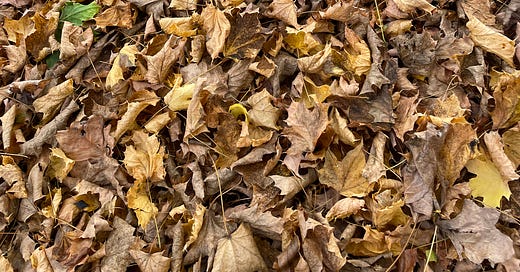Raking leaves is a chore, but not if you leave them in place.
Leaves are host to countless beneficial insects over the winter and provide shelter for wildlife.
After a slow burn for much of October, leaves really tumbled from the trees over the past week. The oak leaves are blanketing the ground with their signature rusty palette and the sugar maples, in all their yellow and orange glory, are adding a vibrant dash. All of which means I’ve been raking a lot of leaves of late, except this year I’m doing it with a slight twist from what’s been my habit.
To backtrack a bit: At our former home outside Washington, DC, a massive oak towered over the property and each fall it would drop thousands upon thousands of leaves. I’d look at the leaves not as a chore but as an opportunity. I’d rake them into piles and then grind them up with a lawn mower or leaf shredder before spreading them onto our plant and shrub beds as instant mulch or storing them in two wire bins for use as compost come spring.
I figured I was being a good environmental steward. I was using the leaves to improve the soil instead of hauling them to the street to be carted off by town trucks for landfills or composting plants. I was creating my own mulch instead of buying shredded hardwood in plastic bags from box store garden departments.
It seems I had it only half-right.
What I didn’t fully appreciate was that the leaves dropped by trees each autumn are themselves teaming with life, most notably caterpillar pupae that will transform into moths or butterflies in spring and provide an essential food source for birds. In addition to creating a natural mulch that suppresses weeds and returns nutrients to the soil, leaves provide a winter habitat for a vast array of wildlife including lizards, frogs, turtles, bees and other insects. That includes lightning bugs, which carry their own popular appeal in early summer evenings.
When it comes to insect survival, chopping leaves with a lawnmower or leaf shredder – as I’d done for years – is only a step better than burning them. Removing leaves from your property all together not only deprives your soil of a natural fertilizer but also reduces insect life that attracts birds and pollinates plants.
Entomologist Doug Tallamy, who teaches at the University of Delaware, has been preaching “leave the leaves” for several years, arguing that instead of clearing leaves off our properties we should leave them where they land. (Or at least rake them from our lawns, paths or driveways into plant beds.) Tallamy’s message, which he conveys in his book Nature’s Best Hope, is that leaves are an essential part of the planet’s intricate and endangered food web. As the Xerces Society, one of the country’s leading advocates for protecting insect life, puts it: “Leaves are habitat, not trash.” [You can read the society’s paper on the issue here.]
It wasn’t until this fall that the message seemed to fully sink in. So this year I’m trying to leave the leaves – or most of them – in place. I have been raking them off the lawn because a thick blanket of leaves can make it difficult for grass to survive. Most, though, are going into shrub beds or the woods. I say most because I’ve still been shredding a portion of the leaves that fall on our driveway and lawn. Once shredded, I’ve been spreading them onto perennial beds to serve as a mulch or collecting them in a large circular plastic container near our compost bins. They’re a great source of carbon when creating compost. It’s a tradeoff, I know, but it seems to me one worth making given the alternative.





Mowed or shredded leaves are really good -- better than whole leaves -- for the "brown" in the compost mix.